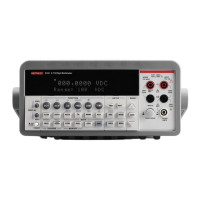Rate
The RATE operation sets the integration time of the A/D converter, the period of time the in-
put signal is measured (also known as aperture). The integration time affects the usable digits,
the amount of reading noise, as well as the ultimate reading rate of the instrument. The integra-
tion time is specified in parameters based on a number of power line cycles (NPLC), where 1
PLC for 60Hz is 16.67msec and 1 PLC for 50Hz and 400Hz is 20msec.
In general, the fastest integration time (FAST (0.1 PLC) from the front panel, 0.01 PLC from
the bus) results in increased reading noise and fewer usable digits, while the slowest integration
time (10 PLC) provides the best common-mode and normal-mode rejection. In-between settings
are a compromise between speed and noise.
The RATE parameters are explained as follows:
• FAST sets integration time to 0.1 PLC. Use FAST if speed is of primary importance (at
the expense of increased reading noise and fewer usable digits).
• MEDium sets integration time to 1 PLC. Use MEDium when a compromise between
noise performance and speed is acceptable.
• SLOW sets integration time to 10 PLC. SLOW provides better noise performance at the
expense of speed.
NOTE
The integration time can be set for any measurement function except frequency, peri-
od, continuity (FAST), and diode test (MEDium). For frequency and period, this value
is gate time or aperture.
For the AC functions, MEDium and SLOW have no effect on the number of power line
cycles. See the discussion on “Bandwidth” that follows.
3-6 Measurement Options

